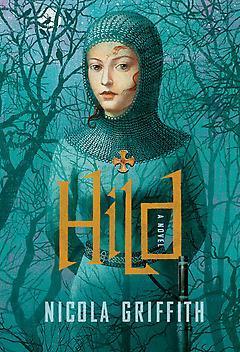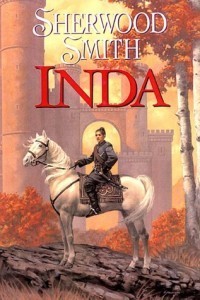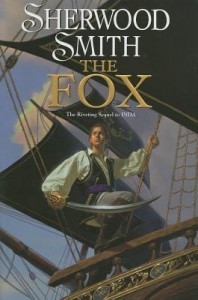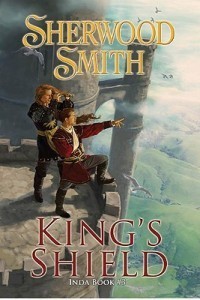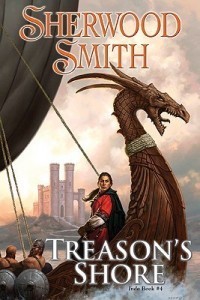Rachel Neumeier's Blog, page 390
November 11, 2013
Just want to call everyone’s attention to –
Nicola Griffith, author of THE BLUE PLACE and its sequels, has just brought out this historical novel about Saint Hilda of Whitby.
Because I loved THE BLUE PLACE so much, this one stepped instantly onto my TBR pile. It’ll be a while before I read it, though, so if you are curious, you might check out this review at tor.com.

November 9, 2013
Defining epic fantasy by example
You know how wildly disparate those definitions of Urban Fantasy were, that I posted about a couple of days ago, right? Well, I have an easy way to define Epic Fantasy, thus:
There, Epic Fantasy defined pictorially. Wasn’t that easy?
Oh, okay, I’m willing to venture, very very briefly, into what makes this series epic fantasy. Aside from its sheer length.
You have no doubt seen plenty of definitions of and lists of epic fantasy. In fact, as you may recall, Liz Bourke and Justin, Jared, and Tansy, all did the 25-essential-titles thing with epic fantasy a while ago.
Now, more than any other subgenre, this is one where I am constantly surprised by what other people consider “epic,” while for a change being able to define pretty clearly where I think everybody else is missing the boat. Like, I don’t think THE CURSE OF CHALION is epic fantasy. Nor Martha Wells’ WHEEL OF THE INFINITE. Both of those are on Liz Bourke’s list. To me, those might be high fantasy, whatever that is, but they are definitely not epic fantasy.
Epic fantasy may frequently involve grand quests and a substantial chance in world order, but those tropes are not sufficient to make a particular work “epic.” To be epic fantasy, a work must also possess sheer scope. I also find myself unwilling to declare that a work is epic fantasy unless it involves multiple points of view. Possibly I find this necessary just to create the sense of grand scale that is essential.
So, for me, epic fantasy must include: Grand scope and scale, multiple points-of-view, at least one grand quest, and a substantial change in the order of the world.
And if you want an example, well, see above.
What the INDA series offers:
Great characterization, with many point-of-view characters who are almost all compelling and enjoyable to read about. I don’t need to mention that pulling this off is quite a trick. Inda himself? He’s definitely not the perfect-uber-hero. He’s just fascinating, especially as Smith quite explicitly gives him some autistic characteristics. Tdor, Tau, the Fox, Evered, Jeje, Hadand, I hardly know what to say. They’re all fantastic characters, complex and realistic. Well, okay, Tau is a bit too good to be true, but he still feels realistic, somehow.
Great writing that doesn’t call attention to itself so that you can easily fall into the story.
A unique quality that makes the books easy to put down, then pick up again days later. You can slip right back into the story. I don’t remember any other series that has this quality for me. One thing that might contribute is that there are many smaller plot arcs that resolve in a sensible number of pages, so that you can find places to stop — but that’s true of other series, and if I stop for several days with them, I’m done. That’s not the case with this one.
Doorstopper length — the books run six to seven hundred pages, and we’re talking small font. For me, the pacing was just fine, because I enjoyed the worldbuilding and all or nearly all the points-of-view that were offered and didn’t long to get through one and back to another. But this series has more than physical heft. These books are not meant to be fast-paced adventure stories. Readers looking for a light beach read aren’t going to be happy with this series.
A society (I mean the Marlovan society, obviously) which is interesting and fun to read about, but basically unbelievable. The writing and characterization are so good you aren’t driven out of the story. So this isn’t actually a problem, at least not for me. So I don’t want to dwell on this. But, well, I will just say that, while an author is free to change human nature in order to build a fictional society, doing so really is going to make that society come across as implausible.
But, as I say, this didn’t bother me. What did bother me from time to time: I SERIOUSLY wanted Durasner to just take a moment to shove Erkric over the side of the ship. That was the second time in the series where I was rolling my eyes over peoples’ inability to JUST TAKE EFFECTIVE STEPS to get rid of a bad guy. What is WITH the good guys in this series that they have to let their WHOLE SOCIETY ride the edge of total disaster rather than just deal efficiently with the bad guy?
Oh, well, I guess that kind of expediency would make for a much shorter story.
Anyway, yeah, highly recommended when you have time to read something on the close order of 2800 pages. I didn’t, really, but I’m glad I didn’t realize how long this series was when I started it, because my year would have been the poorer for putting it off. But if you don’t have that much time, maybe Smith’s YA might be a better choice. I’ve heard good things about SASHARIA EN GARDE.

Nice review of Lord of the Changing Wind -
Over at Fantasy Reads.
Hey, does Kes have Asperger’s syndrome? I never thought of that, just of making her very introverted. It’s an interesting suggestion.
Plus, chalk one up in the “loves the names” column. Yay! I may never use such complicated names again because the people in that column are pretty thoroughly outnumbered.

Literary wedding cakes
So, yeah, Tor.com was definitely worth checking out this morning. Excellent links.
You have to click through and take a look at these literary wedding cakes at Book Riot. It’s hard to top The Cat in the Hat cake. How did the baker even do that?
Which one is your favorite?

Reminds me of Mark’s turning ImpSec HQ into a hotel
Seriously, a hilariously terrible idea that I spotted over at tor.com.
What kinds of rides / shows / displays / hotels do you suppose you would find in this particular theme park? Do you even want to speculate?

November 7, 2013
Books moving up on my wishlist: Mark Newton’s Drakenfeld
So, remember this post on grimdark fantasy by Mark Charan Newton?
This is the one where Newton says:
“Gritty has almost become a sub-genre. Isn’t that weird, when you think about it? That readers, publishers and authors have started talking about violence (and other Bad Things) as a definable, marketable sub-genre? In fiction, here was a kind of unconscious creep. Readers and reviewers … seemed to suggest that increasing violence had become a symbol of good writing in fantasy fiction…”
And yes, it is weird. Also disturbing. Not to mention, you know, completely misguided.
And, as you may recall, this was one of the trends that Newton was reacting to, or against, when he wrote DRAKONFELD: “Lucan Drakenfeld is someone who, at heart, abhors violence. He is cerebral. He’s polite. He doesn’t have a fascination with heaving bosoms. He’s nowhere near as tough as his female bodyguard. But most importantly, he will always think before hitting someone with a sword.”
Anyway, if you don’t recall the post, or didn’t click through the first time I posted a link, you might do so now. Especially because of all the Bill Murray graphic illustrations.
But! The point is, if you were interested but didn’t rush out to buy his book after reading Newton’s post — and I got only so far as to rush out and add it to my wishlist — then you may like to glance at Ana’s review of DRAKONFELD over at The Book Smugglers.
DRAKONFELD is a locked-room murder mystery set in a Roman-inspired secondary world — sounds good so far, right? In fact, I am strongly reminded of Gillian Bradshaw’s RENDER UNTO CAESAR by some aspects of the plot description.
Anyway, Ana’s review definitely makes me shift it upward on my wishlist. But it may be some time — like, February, I’m guessing — before I have time to really whittle down my TBR pile, much less my wishlist. If any of you happen to read this one before I do, please drop me a line and let me know what you think!

November 4, 2013
Competing definitions
So, I was going to write and post this over the weekend, but wow is connectivity bad in Joplin, Missouri. I sure thought the town would be big enough to support decent cell phone connections, but no. At least not where I was.
And then Kenya only placed third in her class. Which was a big class of nice girls — I think eight were in the class — so third is okay, but you know, only Winners Bitch gets the points. Four point major, nice for whomever won.
My friend Laura won Winner’s Dog with her boy, though, so that was nice. I think she needs two more single points to finish him.
Next week another show, then I’m just about done for the year. It’d be nice to finish Kenya this year, but I’m not holding my breath.
So, anyway! On to the actual real topic of the post. I got a kick out of the VERY DIFFERENT definitions of Urban Fantasy which were used by Liz Bourke, Jared Shurin, Justin Landon, and Tansy Rayner Roberts to generate their respective lists of “essential UF.”
Here’s Liz: What is most prominent in the fantasy of the urban, to me, is the combination of anonymity and the need for systems and compromises – a way of operating in the world that doesn’t rely on implicit reciprocity and mutuality – that arises when people live together in numbers exceeding the hundred-odd of the isolate village or the thousand-odd of the tiny towns of the past. Urban fantasy shares DNA with ghost stories, noir crime and the police procedural, as well as fairytale, folklore, and fable. … Although UF and PR are distinct, for the most part, as marketing categories, my definition of urban fantasy as the fantasy of the town doesn’t really allow that distinction.
I like this focus. It’s thoughtful, it does not disregard the actual name of the subgenre, it’s academic in tone — I like academic definitions — and when I read it, I basically found myself going, Sure, Liz, sounds right to me! Plus, and I think this is important, all the books which I’ve read that are on Liz’ list seem like they belong to the UF subgenre.
Then I read Jared’s definition: a) The story is set in our world;
b) The fantastic element is integrated into our world – it hasn’t come from elsewhere; it has always been there. It can be revealed, but it isn’t elsewhere; c) The story is contemporary to the author.
Ah! I said. Interesting! It is interesting and I think it is basically true of what we think of as UF (and Paranormal). But look how the quality “urban” has been entirely removed from this definition. THIS is what I would call Contemporary Fantasy. And I’m not sure it matters whether magic has suddenly appeared or has always been there. But the real problem with Jared’s definition, it seems to me, is that it goes off totally sideways to the books which are sold as UF and thought of as UF, so that his list includes heaps of books which would be thought of as horror. Cthulhu, anyone?
To me, a Venn diagram of fantasy would have all, or nearly all, of UF subsumed within a significantly larger circle that meets Jared’s definition. But if you try to market books as UF and they do not fall within the actual-no-kidding UF subgenre, you are going to have a lot of confused (and annoyed) readers. And including horror in UF would be a big turnoff to readers like me who basically do not like horror.
Now, here’s Justin’s definition: To me “urban fantasy” is all about structure and narrative. It has nothing — I repeat, nothing — to do with milieu. Urban Fantasy has a snarky narrator, almost always first person. It requires a thriller structure.
Wow, I said. Really? Because a) police procedural is not the same as thriller. b) I can think of classic UF that are not first person (WAR FOR THE OAKS leaps to mind.) And c) Then why the blazes call it Urban Fantasy? Even less helpful, this pulls us out of contemporary or contemporary-ish settings altogether. Justin says that if you don’t draw the line where I do, “urban fantasy” becomes a catch all for anything that doesn’t have elves in it. But I think that drawing the line as he does opens up the genre A LOT MORE than any definition that includes milieu. Especially as, when you actually look at his list, he includes SF titles. This is once again a list that a) leaves off most of what actual readers think of as UF, and b) includes a lot of stuff that would leave those readers blinking in astonishment. Naomi Novik’s TEMERAIRE is a great book, but UF?
OKAY. One more. Tansy’s definition: But let’s get back to what urban fantasy actually is. Alternative history with magic. That’s it. That’s why the Charles De Lint books and the Charlaine Harris books and the elves on motorcycles and the Norse gods in suburbia and the sexy angry leather trousers kicking butt are all part of the same thing.
And again I have to disagree, because that would put again put TEMERAIRE into the UF category, where I don’t think it belongs. And JONATHON STRANGE AND MR NORRIL, which I admit I haven’t read (I have it on audio but haven’t listened to it yet — do you KNOW how long it is?) but don’t think is UF (right?)
Tansy goes on to add, “Sometimes, urban fantasy utilises tropes from other genres – especially from the paranormal end of the horror genre, and also from crime. Even the format of the books tends towards the series rather than serial, closer to crime than fantasy. But some urban fantasy doesn’t have crime plots OR horror tropes. Some of it is about the collision of the magical with the mundane, in a world that looks a lot like ours, but has a few key differences.”
And while this is true, I think it still allows far too many titles to be included that really ought to be something else. FIRE AND HEMLOCK is on Tansy’s list. UF? Not to me. BUT most of Tansy’s titles look like they would in fact fall pretty much into what is actually understood, read, and marketed as UF. (I haven’t read most of them, but that’s my impression.) So her definition works better for me than Jared’s or Justin’s.
OKAY. A final, definitive definition of UF. Because if everybody else can do it, so can I, right?
Urban fantasy must be set in an urban setting, usually but not exclusively a contemporary setting, but never in a secondary world or far enough in the past that the setting might as well be a secondary world. Magic has probably been present in the world for a long time and has influenced history to a greater or lesser extent. And the tropes utilized must include those of crime novels or police procedurals.
Does that “must” in the last sentence exclude too many clearly UF titles? I think maybe *I* just threw WAR FOR THE OAKS out of the subgenre. Oops. Back to the drawing board . . .

Battling definitions
So, I was going to write and post this over the weekend, but wow is connectivity bad in Joplin, Missouri. I sure thought the town would be big enough to support decent cell phone connections, but no. At least not where I was.
And then Kenya only placed third in her class. Which was a big class of nice girls — I think eight were in the class — so third is okay, but you know, only Winners Bitch gets the points. Four point major, nice for whomever won.
My friend Laura won Winner’s Dog with her boy, though, so that was nice. I think she needs two more single points to finish him.
Next week another show, then I’m just about done for the year. It’d be nice to finish Kenya this year, but I’m not holding my breath.
So, anyway! On to the actual real topic of the post. I got a kick out of the VERY DIFFERENT definitions of Urban Fantasy which were used by Liz Bourke, Jared Shurin, Justin Landon, and Tansy Rayner Roberts to generate their respective lists of “essential UF.”
Here’s Liz: What is most prominent in the fantasy of the urban, to me, is the combination of anonymity and the need for systems and compromises – a way of operating in the world that doesn’t rely on implicit reciprocity and mutuality – that arises when people live together in numbers exceeding the hundred-odd of the isolate village or the thousand-odd of the tiny towns of the past. Urban fantasy shares DNA with ghost stories, noir crime and the police procedural, as well as fairytale, folklore, and fable. … Although UF and PR are distinct, for the most part, as marketing categories, my definition of urban fantasy as the fantasy of the town doesn’t really allow that distinction.
I like this focus. It’s thoughtful, it does not disregard the actual name of the subgenre, it’s academic in tone — I like academic definitions — and when I read it, I basically found myself going, Sure, Liz, sounds right to me! Plus, and I think this is important, all the books which I’ve read that are on Liz’ list seem like they belong to the UF subgenre.
Then I read Jared’s definition: a) The story is set in our world;
b) The fantastic element is integrated into our world – it hasn’t come from elsewhere; it has always been there. It can be revealed, but it isn’t elsewhere; c) The story is contemporary to the author.
Ah! I said. Interesting! It is interesting and I think it is basically true of what we think of as UF (and Paranormal). But look how the quality “urban” has been entirely removed from this definition. THIS is what I would call Contemporary Fantasy. And I’m not sure it matters whether magic has suddenly appeared or has always been there. But the real problem with Jared’s definition, it seems to me, is that it goes off totally sideways to the books which are sold as UF and thought of as UF, so that his list includes heaps of books which would be thought of as horror. Cthulhu, anyone?
To me, a Venn diagram of fantasy would have all, or nearly all, of UF subsumed within a significantly larger circle that meets Jared’s definition. But if you try to market books as UF and they do not fall within the actual-no-kidding UF subgenre, you are going to have a lot of confused (and annoyed) readers. And including horror in UF would be a big turnoff to readers like me who basically do not like horror.
Now, here’s Justin’s definition: To me “urban fantasy” is all about structure and narrative. It has nothing — I repeat, nothing — to do with milieu. Urban Fantasy has a snarky narrator, almost always first person. It requires a thriller structure.
Wow, I said. Really? Because a) police procedural is not the same as thriller. b) I can think of classic UF that are not first person (WAR FOR THE OAKS leaps to mind.) And c) Then why the blazes call it Urban Fantasy? Even less helpful, this pulls us out of contemporary or contemporary-ish settings altogether. Justin says that if you don’t draw the line where I do, “urban fantasy” becomes a catch all for anything that doesn’t have elves in it. But I think that drawing the line as he does opens up the genre A LOT MORE than any definition that includes milieu. Especially as, when you actually look at his list, he includes SF titles. This is once again a list that a) leaves off most of what actual readers think of as UF, and b) includes a lot of stuff that would leave those readers blinking in astonishment. Naomi Novik’s TEMERAIRE is a great book, but UF?
OKAY. One more. Tansy’s definition: But let’s get back to what urban fantasy actually is. Alternative history with magic. That’s it. That’s why the Charles De Lint books and the Charlaine Harris books and the elves on motorcycles and the Norse gods in suburbia and the sexy angry leather trousers kicking butt are all part of the same thing.
And again I have to disagree, because that would put again put TEMERAIRE into the UF category, where I don’t think it belongs. And JONATHON STRANGE AND MR NORRIL, which I admit I haven’t read (I have it on audio but haven’t listened to it yet — do you KNOW how long it is?) but don’t think is UF (right?)
Tansy goes on to add, “Sometimes, urban fantasy utilises tropes from other genres – especially from the paranormal end of the horror genre, and also from crime. Even the format of the books tends towards the series rather than serial, closer to crime than fantasy. But some urban fantasy doesn’t have crime plots OR horror tropes. Some of it is about the collision of the magical with the mundane, in a world that looks a lot like ours, but has a few key differences.”
And while this is true, I think it still allows far too many titles to be included that really ought to be something else. FIRE AND HEMLOCK is on Tansy’s list. UF? Not to me. BUT most of Tansy’s titles look like they would in fact fall pretty much into what is actually understood, read, and marketed as UF. (I haven’t read most of them, but that’s my impression.) So her definition works better for me than Jared’s or Justin’s.
OKAY. A final, definitive definition of UF. Because if everybody else can do it, so can I, right?
Urban fantasy must be set in an urban setting, usually but not exclusively a contemporary setting, but never in a secondary world or far enough in the past that the setting might as well be a secondary world. Magic has probably been present in the world for a long time and has influenced history to a greater or lesser extent. And the tropes utilized must include those of crime novels or police procedurals.
Does that exclude too many clearly UF titles?

October 31, 2013
Early copies of BLACK DOG –
Are being given away here!
I’m sure I’ll be doing a giveaway or two here as we get closer to February, but hey, here’s your first chance to win one, if you care to click through and enter.

October 30, 2013
25 essential urban fantasies
A truly excellent post from Liz Bourke, first defining “urban fantasy” with a bit more of a thoughtful, in-depth definition that is usually given, thus:
What is most prominent in the fantasy of the urban, to me, is the combination of anonymity and the need for systems and compromises – a way of operating in the world that doesn’t rely on implicit reciprocity and mutuality – that arises when people live together in numbers exceeding the hundred-odd of the isolate village or the thousand-odd of the tiny towns of the past. Urban fantasy shares DNA with ghost stories, noir crime and the police procedural, as well as fairytale, folklore, and fable.
Which is, as I say, a fabulous definition. Of course I JUST DON’T KNOW how my BLACK DOG will best be marketed, because I think it clearly has more of an UF vibe than a PR vibe, AND YET. FINE. Liz has convinced me, I can’t call it UF if it’s rural. FINE. I’m going to go with calling it Contemporary Fantasy and I hope that term really does subsume the UF category. Or I guess it would actually overlap in Venn diagram style. Whatever.
You also know what’s interesting? That I agree that UF shares tropes with noir crime and the police procedural, and I had to admit, thinking of it that way, none of that is in BLACK DOG. Though it totally is in the other rural fantasy that leaps to mind for both Liz and me: Deb Coates’ WIDE OPEN. Coates’ book also draws on folklore, and that’s where it crosses genres with BLACK DOG.
Then Liz defines “essential”; and then, of course she provides her list. Here are the ones I’ve read:
2. The Onyx Court series, by Marie Brennan (2008-2011). A faerie court, bound to the city of London. I didn’t really like this series, but I think it was very well written. I gave it to someone who may appreciate it more than I did.
6. James Asher series, by Barbara Hambly (1988-forthcoming). Bleak and atmospheric novels involving vampires, set in Europe in the years preceding the Great War. Breath-taking books. I totally agree about these.
7. Buffy the Vampire Slayer, television series (1997-2003). Enormously influential. Not single-handedly responsible for the success of urban contemporary fantasy with vampires and werewolves as a subgenre, but I daresay it didn’t hurt. I’m sure we all loved “Buffy”, right? I used to watch it with a friend via phone, since we didn’t live that close together.
8. Anita Blake series, by Laurell K. Hamilton (1993-forthcoming). I agree with every word Liz says about this series. A total trainwreck, but the first books are quite good.
9. The Vicki Nelson series, by Tanya Huff (1991-1997). I tried one of these, thought the plot got ridiculously cluttered (vampires! AND, oh, look, aliens!) and quit. Since I love Huff’s Valor series, I’m willing to believe that some of the books in this series would appeal to me more.
10. The Kitty Norville werewolf series, by Carrie Vaughn (2005-forthcoming). Werewolves! Vampires! Talk radio! I’m cheating by including this series here, because I haven’t read any of the books yet. But I mean to! I do keep hearing about them! And it’s almost the same situation with:
14. Above, by Leah Bobet (2012). Set in Toronto. Magnificent, dark, strange, affecting. I actually have this one on my Kindle — it may have been the first book I put on my Kindle, actually. I badly want to read it . . . but I badly want to read a lot of things, and did I mention I’m writing now? And working my way (slowly) through the INDA series by Sherwood Smith? So, yeah, not holding my breath.
19. Beka Cooper series, by Tamora Pierce (2006-2011). The first two books of which are police-procedural second-world urban fantasy. And really kind of lovely. I totally agree AND I agree that the third book was not as good as the first two. I like long slow books, okay? And even I think a hundred pages should have been cut from the third Beka Cooper book. Two hundred.
The! Single! Book! That should most be on Liz’s list but isn’t: WAR FOR THE OAKS by Emma Bull. To me, although that one has an important romance, it is clearly UF and not PR. Agree / disagree?
I’ll look forward to checking out the UF lists from the other participants. I wonder if any of them will include WAR FOR THE OAKS?
If you click through and read Liz’s whole list, are there any other titles any of you think CLEARLY should be on anybody’s essential UF list? Me, I’m willing to take both Brigg’s Mercy Thompson and Andrew’s Kate Daniels as PR, but hereby declare that they’re essential in that genre. Agree / disagree about that?


